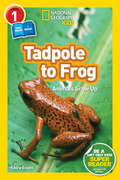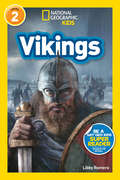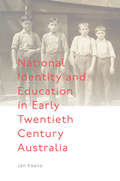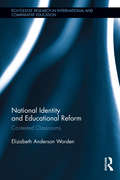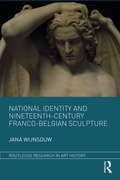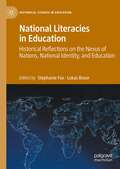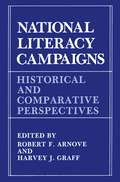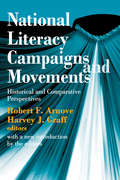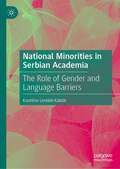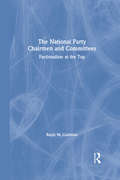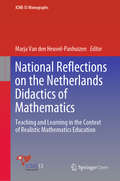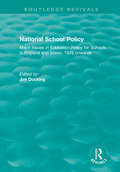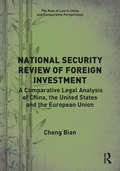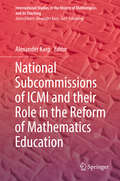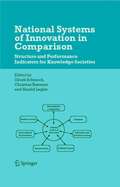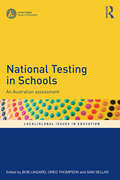- Table View
- List View
National Geographic Kids Readers: Tadpole to Frog (Readers)
by National Geographic Kids Shira EvansCaterpillar to butterfly, tadpole to frog – some creatures take growing up to a whole new level!
National Geographic Kids Readers: Vikings (Readers)
by National Geographic Kids Libby RomeroMeet the seafaring adventurers, storytellers, and famous figures of Norse history in this new Leveled Reader, perfect for independent readers and kids who love learning about ancient cultures.
National Geographic Kids Readers: Wolverines (Readers)
by National Geographic Kids Melissa StewartSuperhero and comic book force? Sure, but also a real-life animal! Find out in this Level 3 Reader how fierce wolverines, who are expert survivors, can be even more fantastic than those in movies and graphic novels.
National Geographic Reader: Reptiles (National Geographic Readers)
by National Geographic KidsFind out about snakes, crocodiles, lizards, turtles, and other reptiles in this new co-reader from National Geographic Kids.
National Identity and Education in Early Twentieth Century Australia
by Jan KeaneThis fascinating book explores how curriculum content in education was used to cultivate a sense of Australian national identity during the first two decades of the twentieth century. Providing a comprehensive picture of the entire reading curriculum in Victorian government schools over a period of almost two decades, the author demonstrates that, contrary to received wisdom, the Department of Education made every effort to integrate children of different backgrounds. Using three dimensions frequently cited in national identity theory – landscape, history, and mythology – readers are shown how material was chosen specifically to engage young white settler children and to help them overcome their sense of Australia as the ‘other’. National Identity and Education in Early Twentieth Century Australia not only brings about a clearer understanding of how Australia came to be ‘Australian’ in character, it establishes how curriculum content may be brought into the service of nation-building across the globe.
National Identity and Education in Early Twentieth Century Australia
by Jan KeaneThis fascinating book explores how curriculum content in education was used to cultivate a sense of Australian national identity during the first two decades of the twentieth century. Providing a comprehensive picture of the entire reading curriculum in Victorian government schools over a period of almost two decades, the author demonstrates that, contrary to received wisdom, the Department of Education made every effort to integrate children of different backgrounds. Using three dimensions frequently cited in national identity theory – landscape, history, and mythology – readers are shown how material was chosen specifically to engage young white settler children and to help them overcome their sense of Australia as the ‘other’. National Identity and Education in Early Twentieth Century Australia not only brings about a clearer understanding of how Australia came to be ‘Australian’ in character, it establishes how curriculum content may be brought into the service of nation-building across the globe.
National Identity and Educational Reform: Contested Classrooms (Routledge Research in International and Comparative Education)
by Elizabeth Anderson WordenNational identity in Moldova remains contested despite repeated attempts by governments, historians, and educators to cultivate a shared sense of national belonging through the development of history textbooks. Concern over professional status and distrust of the government’s motivations halted these reforms, demonstrating that the success of such efforts greatly depends on teachers’ and citizens’ social memory and everyday lives. This volume looks at educational reform and the struggle over national identity in the history classroom from the perspectives of five different groups: elected politicians, Ministry of Education officials, textbook authors and historians, teachers, and students. Each chapter explores the actors’ motivations and agendas regarding reform, their role in promoting or obstructing the reform process, and their opinions about the ensuing controversy. Drawing on months of fieldwork and original research, author Elizabeth Worden examines the importance of teachers and students in the success or failure of a reform initiative.
National Identity and Educational Reform: Contested Classrooms (Routledge Research in International and Comparative Education)
by Elizabeth Anderson WordenNational identity in Moldova remains contested despite repeated attempts by governments, historians, and educators to cultivate a shared sense of national belonging through the development of history textbooks. Concern over professional status and distrust of the government’s motivations halted these reforms, demonstrating that the success of such efforts greatly depends on teachers’ and citizens’ social memory and everyday lives. This volume looks at educational reform and the struggle over national identity in the history classroom from the perspectives of five different groups: elected politicians, Ministry of Education officials, textbook authors and historians, teachers, and students. Each chapter explores the actors’ motivations and agendas regarding reform, their role in promoting or obstructing the reform process, and their opinions about the ensuing controversy. Drawing on months of fieldwork and original research, author Elizabeth Worden examines the importance of teachers and students in the success or failure of a reform initiative.
National Identity and Nineteenth-Century Franco-Belgian Sculpture (Routledge Research in Art History)
by Jana WijnsouwThis book elaborates on the social and cultural phenomenon of national schools during the nineteenth century, via the less studied field of sculpture and using Belgium as a case study. The role, importance of, and emphasis on certain aspects of national identity evolved throughout the century, while a diverse array of criteria were indicated by commissioners, art critics, or artists that supposedly constituted a "national sculpture." By confronting the role and impact of the four most crucial actors within the artistic field (politics, education, exhibitions, public commissions) with a linear timeframe, this book offers a chronological as well as a thematic approach. Artists covered include Guillaume Geefs, Eugène Simonis, Charles Van der Stappen, Julien Dillens, Paul Devigne, Constantin Meunier, and George Minne.
National Identity and Nineteenth-Century Franco-Belgian Sculpture (Routledge Research in Art History)
by Jana WijnsouwThis book elaborates on the social and cultural phenomenon of national schools during the nineteenth century, via the less studied field of sculpture and using Belgium as a case study. The role, importance of, and emphasis on certain aspects of national identity evolved throughout the century, while a diverse array of criteria were indicated by commissioners, art critics, or artists that supposedly constituted a "national sculpture." By confronting the role and impact of the four most crucial actors within the artistic field (politics, education, exhibitions, public commissions) with a linear timeframe, this book offers a chronological as well as a thematic approach. Artists covered include Guillaume Geefs, Eugène Simonis, Charles Van der Stappen, Julien Dillens, Paul Devigne, Constantin Meunier, and George Minne.
National Literacies in Education: Historical Reflections on the Nexus of Nations, National Identity, and Education (Historical Studies in Education)
by Stephanie Fox Lukas BoserThis edited volume provides an international overview of research on nationalism in education. In light of emerging neo-nationalism and national answers to global challenges, the book contributes to a growing and desperately needed discussion on how we can understand and deal with the involvement of education in phenomena of nations and nationalisms in school, curriculum, theory and research. In this book, internationally renowned scholars as well as doctoral students and postdocs from Asia, Europe, America, and Australia show how the history of education can theoretically and empirically deal with the concept(ion)s of nation and nationalism.
National Literacy Campaigns: Historical and Comparative Perspectives
by R.F. Arnove H.J. GraffWe came to the task of editing this book from different disciplines and back grounds but with a mutuality of interest in exploring the concept of literacy campaigns in historical and comparative perspective. One of us is a professor of comparative education who has participated in and written about literacy campaigns in Third World countries, notably Nicaragua; the other is a com parative social historian who has written on literacy campaigns in Western his tory. Both of us believed that literacy could only be understood in particular As Harvey Graff has noted, "to consider any of the ways in historical contexts. which literacy intersects 'with social, political, economic, cultural, or psychological life ... requires excursions into other records.") Thus, we have set out in this edited collection to explore some five hundred years of literacy campaigns in vastly different societies: Reformation Germany, early modern Sweden and Scotland, the nineteenth-century United States, nineteenth- and early twentieth-century Russia and the Soviet Union, pre Revolutionary and Revolutionary China, and a variety of Third World countries in the post-World War II period (Tanzania, Cuba, Nicaragua, and India). In addition, we have included studies of the UNESCO-sponsored Experimental World Literacy Program and recent adult literacy efforts in three industrialized Western countries (the United Kingdom, France, and the United States).
National Literacy Campaigns and Movements: Historical and Comparative Perspectives
by Jose Carlos ChiaramonteMajor campaigns to raise levels of literacy have taken place for centuries and share many common elements. But despite literary campaigns spanning over five decades, 860 million adults still lack minimal ability to read, write, and calculate. Why is literacy of such great importance and why have so many years of campaigning for it not been successful in fully overcoming this obstacle? "National Literacy Campaigns and Movements" explores these questions by examining campaigns in vastly different societies from a historical and comparative perspective.The volume focuses on literacy movements from the past, including those of Reformation Germany, early modern Sweden and Scotland, nineteenth-century United States, nineteenth- and early twentieth-century Russia and the Soviet Union, pre-Revolutionary and Revolutionary China, and Tanzania, Cuba, Nicaragua, and India. Contributors analyze literacy goals and outcomes in specific contexts. The editors distinguish quantitative and qualitative dimensions of literacy activities, such as the difference between the spread of literacy and patterns of its use. The common enterprise of this book is to expand upon the contributors' previous research to include a comparative dimension.This book offers the first systematic attempt to examine, critically and comparatively, the concepts and facts of large-scale literacy campaigns in more than a dozen societies over nearly five-hundred years. It offers a valuable historical lesson not only for historians, but also for educators: that instead of concentrating only on the recent period, we should use the vast and complex history of literacy movements to shed understanding on the present and future of literacy. A major new introduction to this edition asserts recent literary campaigns and the lessons provided by their success and failures. It also describes how the focus of some movements has evolved.
National Literacy Campaigns and Movements: Historical and Comparative Perspectives
by Jose Carlos ChiaramonteMajor campaigns to raise levels of literacy have taken place for centuries and share many common elements. But despite literary campaigns spanning over five decades, 860 million adults still lack minimal ability to read, write, and calculate. Why is literacy of such great importance and why have so many years of campaigning for it not been successful in fully overcoming this obstacle? "National Literacy Campaigns and Movements" explores these questions by examining campaigns in vastly different societies from a historical and comparative perspective.The volume focuses on literacy movements from the past, including those of Reformation Germany, early modern Sweden and Scotland, nineteenth-century United States, nineteenth- and early twentieth-century Russia and the Soviet Union, pre-Revolutionary and Revolutionary China, and Tanzania, Cuba, Nicaragua, and India. Contributors analyze literacy goals and outcomes in specific contexts. The editors distinguish quantitative and qualitative dimensions of literacy activities, such as the difference between the spread of literacy and patterns of its use. The common enterprise of this book is to expand upon the contributors' previous research to include a comparative dimension.This book offers the first systematic attempt to examine, critically and comparatively, the concepts and facts of large-scale literacy campaigns in more than a dozen societies over nearly five-hundred years. It offers a valuable historical lesson not only for historians, but also for educators: that instead of concentrating only on the recent period, we should use the vast and complex history of literacy movements to shed understanding on the present and future of literacy. A major new introduction to this edition asserts recent literary campaigns and the lessons provided by their success and failures. It also describes how the focus of some movements has evolved.
National Minorities in Serbian Academia: The Role of Gender and Language Barriers
by Karolina Lendák-KabókThis book offers an intersectional analysis of secondary and tertiary educational pathways of ethnic Hungarians, Romanians and Slovaks in the Autonomous Province of Vojvodina, Serbia. After a detailed overview of the legal and institutional context of national minority education in Serbia, the book presents qualitative and quantitative research results to illuminate the often invisible linguistic and cultural barriers that national minority high school graduates, university students and faculty may encounter. The author also focuses on the position of national minority women in Serbian higher education and academia, shedding light on the very gendered nature of the ‘glass ceiling’ that often holds members of national minority communities back from career building. This book will be of interest to policymakers seeking nuanced interpretations of multifocal inequalities, as well as academics in fields such as gender studies, migration studies, minority languages and communities, and the sociology of education.
The National Party Chairmen and Committees: Factionalism at the Top
by Andrew GoldmanThis study traces the history of the national committee chairmanships of the two major political parties in the United States, emphasizing the national conventions and presidential campaigns - where national factions often reveal themselves. Candidate and ideolological factionalism, as the evidence of this volume demonstrates, has been the principal engine of convention action. Factional conflicts have had consequences not just for the political parties but for the party system itself. The institutional history of the two national committees and their chairmanships reveals a previously unrecorded aspect of United States national party development.
The National Party Chairmen and Committees: Factionalism at the Top
by Andrew GoldmanThis study traces the history of the national committee chairmanships of the two major political parties in the United States, emphasizing the national conventions and presidential campaigns - where national factions often reveal themselves. Candidate and ideolological factionalism, as the evidence of this volume demonstrates, has been the principal engine of convention action. Factional conflicts have had consequences not just for the political parties but for the party system itself. The institutional history of the two national committees and their chairmanships reveals a previously unrecorded aspect of United States national party development.
National Reflections on the Netherlands Didactics of Mathematics: Teaching and Learning in the Context of Realistic Mathematics Education (ICME-13 Monographs)
by Marja Van den Heuvel-PanhuizenThis open access book, inspired by the ICME 13 Thematic Afternoon on “European Didactic Traditions”, consists of 17 chapters, in which educators from the Netherlands reflect on the teaching and learning of mathematics in their country and the role of the Dutch domain-specific instruction theory of Realistic Mathematics Education.Written by mathematics teachers, mathematics teacher educators, school advisors, and developers and researchers in the field of instructional material, textbooks, and examinations, the book offers a multitude of perspectives on important issues in Dutch mathematics education, both at primary and secondary school levels. Topics addressed include the theoretical underpinnings of the Dutch approach, the subject of mathematics in the Dutch educational system, teacher education and testing, the history of mathematics education and the use of history in teaching of mathematics, changes over time in subject matter domains and in the use of technology, and the process of innovation and how the Dutch and in particular one Dutch institute have worked on the reform.
National School Policy: Major Issues in Education Policy for Schools in England and Wales, 1979 onwards (Routledge Revivals)
by Jim DockingPublished in 1996, this book presents a broad overview of the development of educational policy for schools in England and Wales since Margaret Thatcher’s Conservative administration took office in 1979. It reviews the separate strands of education policy as it relates to curriculum, equal educational opportunities, diversity and choice and management policies, and combines these with an overall appraisal of the direction of the schools system in the two decades before it was written. The book thereby provides a comprehensive text for undergraduate and postgraduate students which raises issues for debate and includes support material for discussion. It will also be of interest to school governors, educationalists and all those who care about the direction of educational change.
National School Policy: Major Issues in Education Policy for Schools in England and Wales, 1979 onwards (Routledge Revivals)
by Jim DockingPublished in 1996, this book presents a broad overview of the development of educational policy for schools in England and Wales since Margaret Thatcher’s Conservative administration took office in 1979. It reviews the separate strands of education policy as it relates to curriculum, equal educational opportunities, diversity and choice and management policies, and combines these with an overall appraisal of the direction of the schools system in the two decades before it was written. The book thereby provides a comprehensive text for undergraduate and postgraduate students which raises issues for debate and includes support material for discussion. It will also be of interest to school governors, educationalists and all those who care about the direction of educational change.
National Security Review of Foreign Investment: A Comparative Legal Analysis of China, the United States and the European Union (The Rule of Law in China and Comparative Perspectives)
by Cheng BianIn recent years, China, the US, and the EU and its Member States have either promulgated new national laws and regulations or drastically revised existing ones to exert more rigorous government control over inward foreign direct investment (FDI). Such government control pertains to the establishment of an ex-ante review regime of FDI in the host state in sectors that are considered as ‘sensitive’ or ‘strategic’, with an aim to mitigate the security-related implications. This book conducts a systematic and up-to-date comparative study of the national security review regimes of China, the US, and the EU, using Germany as an exampling Member State. It answers a central research question of how domestic law should be formulated to adequately protect national security of the host state whilst posing minimum negative impacts to the free flow of cross-border investment. In addition to analyzing the latest development of the national security review regimes in aforementioned jurisdictions and identifying their commonalities and disparities, this book establishes a normative framework regarding the design of a national security review regime in general and proposes specific legislative recommendations to further clarify the law. This book will be of interest to scholars in the field of international and comparative investment law, investors who seek better compliance programs in the host state, and policymakers who aim for high-quality regulation on foreign investment.
National Security Review of Foreign Investment: A Comparative Legal Analysis of China, the United States and the European Union (The Rule of Law in China and Comparative Perspectives)
by Cheng BianIn recent years, China, the US, and the EU and its Member States have either promulgated new national laws and regulations or drastically revised existing ones to exert more rigorous government control over inward foreign direct investment (FDI). Such government control pertains to the establishment of an ex-ante review regime of FDI in the host state in sectors that are considered as ‘sensitive’ or ‘strategic’, with an aim to mitigate the security-related implications. This book conducts a systematic and up-to-date comparative study of the national security review regimes of China, the US, and the EU, using Germany as an exampling Member State. It answers a central research question of how domestic law should be formulated to adequately protect national security of the host state whilst posing minimum negative impacts to the free flow of cross-border investment. In addition to analyzing the latest development of the national security review regimes in aforementioned jurisdictions and identifying their commonalities and disparities, this book establishes a normative framework regarding the design of a national security review regime in general and proposes specific legislative recommendations to further clarify the law. This book will be of interest to scholars in the field of international and comparative investment law, investors who seek better compliance programs in the host state, and policymakers who aim for high-quality regulation on foreign investment.
National Subcommissions of ICMI and their Role in the Reform of Mathematics Education (International Studies in the History of Mathematics and its Teaching)
by Alexander KarpICMI (or IMUK) was founded in 1908 and initiated the establishment of national subcommissions to launch national activities in response to the IMUK agenda and to promote the reform proposals within each member country.While ICMI’s activities were thoroughly studied, the activities of the national subcommissions are studied only very marginally. In the meantime, their work has been of major importance – both because of their role in exploring and documenting the development of mathematics education at the beginning of the 20th century, and because of the changes and new ideas which they brought to their countries. Importantly, even if some results of their activities were analyzed within their countries in the corresponding languages, almost nothing is known internationally. This book is planned to deepen our knowledge on at least some of the national subcommissions. The book will interest both researchers and others interested in mathematics education and its development.
National Systems of Innovation in Comparison: Structure and Performance Indicators for Knowledge Societies
by Ulrich Schmoch Christian Rammer Harald LeglerThe concept of National Systems of Innovation was introduced as a method to describe the various elements which contribute to innovation performance and their interaction. In this book, the innovation structures of a broad set of countries are compared. It provides more than a pure compilation of quantitative indicators for international benchmarking, supporting an appropriate interpretation of the referring results and suggesting relevant conclusions for innovation policy.
National Testing in Schools: An Australian assessment (Local/Global Issues in Education)
by Bob Lingard Sam Sellar Greg ThompsonOver the last two decades, large-scale national, or provincial, standardised testing has become prominent in the schools of many countries around the globe. National Testing in Schools: An Australian Assessment draws on research to consider the nature of national testing and its multiple effects, including: media responses and constructions such as league tables of performance pressures within school systems and on schools effects on the work and identities of principals and teachers and impacts on the experience of schooling for many young people, including those least advantaged. Using Australia as the case site for global concerns regarding national testing, this book will be an invaluable companion for education researchers, teacher educators, teacher education students and teachers globally.
